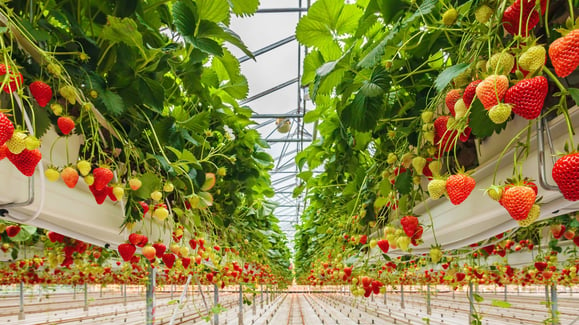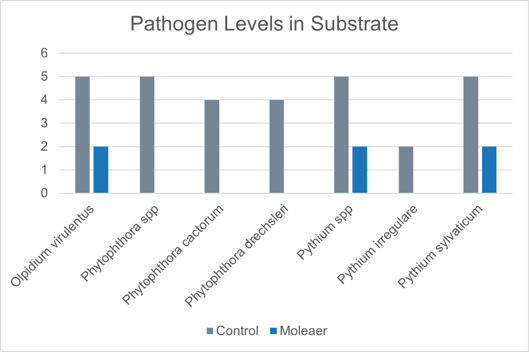Strawberries have high oxygen-demanding roots and are susceptible to a variety of root pathogens; therefore, they require high-quality irrigation water to thrive. Oxygen nanobubbles provide both the benefits of high levels of dissolved oxygen (DO) in the root zone as well as the oxidative and scouring power of nanobubbles to suppress water-borne pathogens.
Dissolved Oxygen and Greenhouse Strawberry Cultivation
It is well known in the horticulture world that plants need oxygen in the root zone to respire or burn glucose that’s been transported from the leaves through photosynthesis. Without oxygen, root respiration does not take place and plants are negatively impacted.
Strawberry plants, requiring more oxygen than other species, need high levels of DO in irrigation water to produce healthy roots that respire and develop healthy strawberry crops.
This can be challenging during summer months when water temperatures rise, as warmer water cannot hold as much DO as cooler water.
There are several options for growers to increase their DO levels, however, not all options are cost-effective, sustainable or efficient. Popular methods include disk aerators, extreme agitation, air stones, Venturi, stabilized peroxide, and nanobubble technology. While traditional aeration, agitation, air stones are Venturi do increase DO levels, some by more than others, they are generally not very efficient and require higher energy input while achieving less than stellar results. Chemical dosing is not sustainable and can create additional concerns with overdosing and damaging roots.

The last method is nanobubble technology, which is efficient, sustainable and cost-effective for growers. Moleaer’s nanobubble technology is the most efficient gas transfer technology on the market for strawberry growers, with over 85% gas transfer efficiency that stays in the water for long periods of time.
Additionally, Moleaer’s technology keeps DO levels optimal even during the warmer summer months.
Root Health and Disease Pressure for Greenhouse Strawberries
During trials by Delphy Research Institute in the Netherlands, oxygen nanobubble-enriched irrigation water for hydroponic greenhouse strawberries resulted in an increased yield of 14% from transferring high levels of DO that improved root development and respiration.
In addition to high yields and increased DO, Delphy also reported a 74% reduction in Pythium counts and lower instances of Phytophthora in their strawberries grown in nanobubble-enriched irrigation water.
Another commercial case study at Aardbeienkwekerij Penninx, a strawberry grower in the Netherlands, showed 11.5% yield increase, cleaner water in the irrigation system, reduce chemical usage for sanitizing and lower levels of Pythium and Phytophthora species. The graph below shows the pathogens levels, 1 being the lowest levels and 6 being the highest.

Pythium and Phytophthora are two root pathogens that can be present in irrigation water and negatively impact plant health and crop production. Successful greenhouse strawberry growers understand that hygiene is a critical key to profitable operation. Keeping the greenhouse environment and irrigation water free of disease is paramount.
To ensure irrigation water is pathogen-free and of the highest quality, greenhouse strawberry growers have several options. However, only nanobubble technology provides both benefits of DO and the power of nanobubbles to suppress water-borne pathogens and scour biofilm from irrigation piping.
That is why over 500 greenhouse growers worldwide already have Moleaer’s nanobubble generation systems in operation. Nanobubble generators provide a chemical-free method of water disinfection and at the same time provide optimal plant growth and health.
For greenhouse strawberry growers specifically, nanobubble generators ensure unmatched hygiene and maximum yields – both of which are key to profitability.
Nanobubbles do this through two modes of action:
- First, nanobubbles enhance oxidation by delivering oxygen supersaturation to naturally oxidize and suppress water-borne pathogens that cause common root disease.
- Second, because of their hard surface and strong surface charge, nanobubbles physically scour and abrade biofilm deposits on irrigation piping and cover the surfaces so future biofilm isn’t able to develop.
These two distinct benefits of nanobubbles help strawberry growers reduce their use of chemical dosing for system hygiene and pathogen control.
The best hygiene and the highest yields are achieved naturally and sustainably– that’s what Moleaer technology offers. Our generators can be installed in multiple locations in greenhouses and outdoor irrigation systems.

